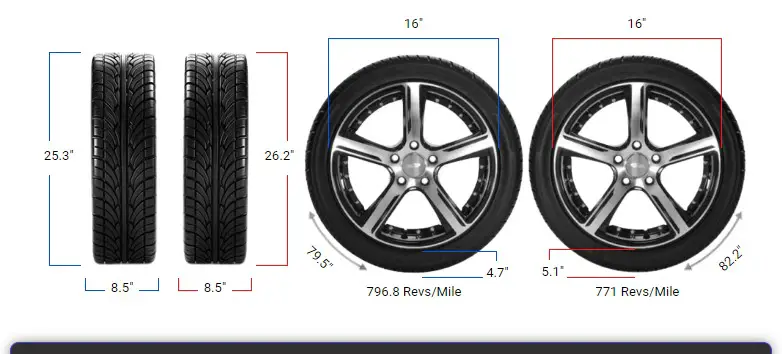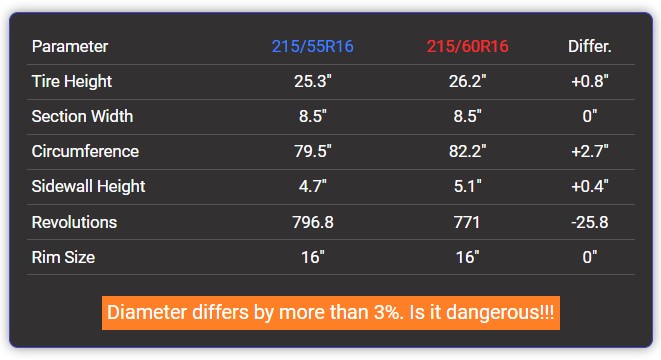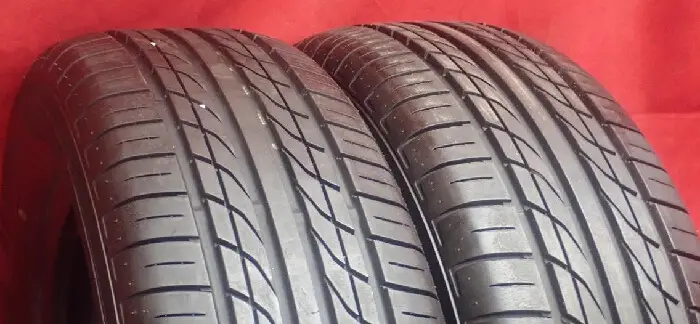Tire Size 215/55r16 vs 215/60r16

The main difference between tire sizes 215/55R16 and 215/60R16 lies in the aspect ratio. While the width remains the same at 215mm, the 60 aspect ratio of the 215/60R16 results in a taller sidewall and greater overall diameter than the 55 aspect ratio of the 215/55R16.

Fitment Guide
The 215/60R16 has a 3.3% larger diameter than the 215/55R16, crossing the 3% barrier where adaptations may be needed to prevent issues with larger replacement tires. Leveling kits or small lifts could be required to accommodate the extra clearance.

Ground Clearance
With a diameter of 664.4mm, the 215/60R16 provides 21.5mm more ground clearance versus the 215/55R16 at 642.9mm. This added clearance benefits off-road driving, helping prevent scrapes over rocks or rugged terrain.
However, it also lowers the speedometer reading slightly. The reduced 642.9mm clearance of the 215/55R16 increases the risks of scraping on obstacles but gives a higher speedometer reading.
Gas Mileage
Owing to a marginally smaller contact patch and lower rotating mass, the 215/55R16 offers slightly better fuel efficiency, an important factor for daily driving and long trips.
The larger 215/60R16 diameter and width can reduce economy through increased rolling resistance and weight.
Ride Comfort
While the 215/55R16 may give a smoother highway ride, the extra sidewall height of the 215/60R16 provides superior impact absorption and cushioning over rough or uneven terrain. Its taller 60 aspect ratio absorbs more shocks for better comfort off-road.

Aesthetics
Visually, the difference is minor. The 215/60R16 will have a slightly taller sidewall, creating a subtly “stretched” look versus the 215/55R16.
This aesthetic can suit trucks and SUVs well. However, the lower profile 215/55R16 contributes better to aerodynamic efficiency.
Handling & Stability
With a shorter sidewall, the 215/55R16 offers sharper handling and quicker turn-in on pavement. The taller 215/60R16 sidewall exhibits more flex, slightly reducing handling precision. However, both deliver responsive, stable handling overall.
Noise & Vibration
The 215/55R16’s stiffer sidewall transmits more road noise and vibration into the cabin. The extra flexibility of the 215/60R16 dampens noise and vibration better. However, the differences are minor, providing a quiet, smooth ride.
Durability & Wear
The 55-aspect ratio tire potentially displays more even treadwear and longer service life. While the 60 aspect ratio absorbs more impact, its added weight could increase wear on other components.

Adverse Conditions
The narrower 215/55R16 can cut through to the pavement more effectively in snow or ice. The wider 215/60R16 provides better traction in specific off-road, muddy settings. Both handle adverse conditions well overall.
Speedometer Difference
At an actual vehicle speed of 20 mph, the speedometer reading is slightly higher with 215/60r16 tires compared to 215/55r16 tires.
Specifically, the speedometer indicates 20.67 mph with the 215/60 tires and 20.00 mph with the 215/55s. This 0.67 mph difference is due to the larger diameter of the 215/60 tires.
While drivers may notice a small increase in indicated speed with the 215/60s, the discrepancy between these tire sizes is minor overall.
Alternative For 215/60r16
You can find a concise comparison of tire sizes based on their overall diameter, including the percentage difference from the standard size.
| Tire Size | Overall Diameter | Difference |
|---|---|---|
| 185/65R16 | 25.4″ (646 mm) | -2.7% |
| 135/90R16 | 25.6″ (650 mm) | -2.1% |
| 245/50R16 | 25.7″ (652 mm) | -1.8% |
| 205/60R16 | 25.7″ (652 mm) | -1.8% |
| 225/55R16 | 25.7″ (654 mm) | -1.5% |
| 275/45R16 | 25.7″ (654 mm) | -1.5% |
| 155/80R16 | 25.7″ (654 mm) | -1.5% |
| 315/40R16 | 25.9″ (658 mm) | -0.9% |
| 255/50R16 | 26.1″ (662 mm) | -0.3% |
| 235/55R16 | 26.1″ (664 mm) | 0% |
| 145/90R16 | 26.3″ (668 mm) | 0.6% |
| 240/55R16 | 26.4″ (670 mm) | 0.9% |
| 165/80R16 | 26.4″ (670 mm) | 0.9% |
| 265/50R16 | 26.5″ (672 mm) | 1.2% |
| 205/65R16 | 26.5″ (672 mm) | 1.2% |
| 225/60R16 | 26.6″ (676 mm) | 1.8% |
| 245/55R16 | 26.6″ (676 mm) | 1.8% |
| 275/50R16 | 26.9″ (682 mm) | 2.7% |
Alternative For 215/55r16
This table shows various tire sizes along with their overall diameter and the percentage difference from a standard size of 215/55R16.
| Tire Size | Overall Diameter | Difference |
|---|---|---|
| 245/45R16 | 24.6″ (626 mm) | -2.5% |
| 185/60R16 | 24.7″ (628 mm) | -2.2% |
| 225/50R16 | 24.9″ (632 mm) | -1.6% |
| 125/90R16 | 24.9″ (632 mm) | -1.6% |
| 205/55R16 | 24.9″ (632 mm) | -1.6% |
| 205/50R17 | 25.1″ (638 mm) | -0.6% |
| 145/80R16 | 25.1″ (638 mm) | -0.6% |
| 195/60R16 | 25.2″ (640 mm) | -0.3% |
| 265/45R16 | 25.4″ (644 mm) | 0.3% |
| 185/65R16 | 25.4″ (646 mm) | 0.6% |
| 135/90R16 | 25.6″ (650 mm) | 1.2% |
| 245/50R16 | 25.7″ (652 mm) | 1.6% |
| 205/60R16 | 25.7″ (652 mm) | 1.6% |
| 155/80R16 | 25.7″ (654 mm) | 1.9% |
| 275/45R16 | 25.7″ (654 mm) | 1.9% |
| 225/55R16 | 25.7″ (654 mm) | 1.9% |
| 315/40R16 | 25.9″ (658 mm) | 2.5% |
| 195/65R16 | 26″ (660 mm) | 2.8% |
Can I use 215/60r16 instead of 215/55r16?
Replacing tires with more than a 3% difference in overall diameter is not recommended. In this case, the overall diameter of a 215/60r16 tire is 26.16 inches, while the 215/55r16 tire measures 25.31 inches in diameter.
This leads to a difference of about 0.85 inches, or approximately 3.3%. As this is slightly over the advised 3% limit, using a 215/60r16 tire instead of a 215/55r16 might not be suggested.
Can I put a 215/60r16 on a 215/55r16?
As the data indicates, both 215/60r16 and 215/55r16 tires have a compatible rim width range of 6.0-7.5 inches. This suggests that you can mount a 215/60r16 tire on a rim designed for a 215/55r16 tire, given the compatibility in rim width ranges.
Our Observation
While the 215/55R16 and 215/60R16 tires deliver solid overall performance, their differences suit particular applications best.
The taller sidewall and diameter of the 215/60R16 provide enhanced off-road clearance and absorbency that lend well to rugged terrain at the cost of slightly reduced handling and fuel economy.
On the other hand, the 215/55R16 optimizes on-road dynamics and efficiency with its shorter sidewall, though it loses some capability off-road.
Visually and in noise, the tires are quite comparable. For most drivers who split time between pavement and moderate trails, the more balanced 215/55R16 is ideal.
But for true off-road enthusiasts, the benefits of the 215/60R16 sidewall flex and added clearance would undoubtedly be worthwhile. Matching the tire to the vehicle’s expected use is key to maximizing its advantages.

Meet Caitlin McCormack, a Tire Size Expert and Blogger Passionate About Everything Related to Tires. With Years of Experience in the Tire Industry, Caitlin Has Become an Expert in Tire Sizes and Their Impact on Vehicle Performance.
